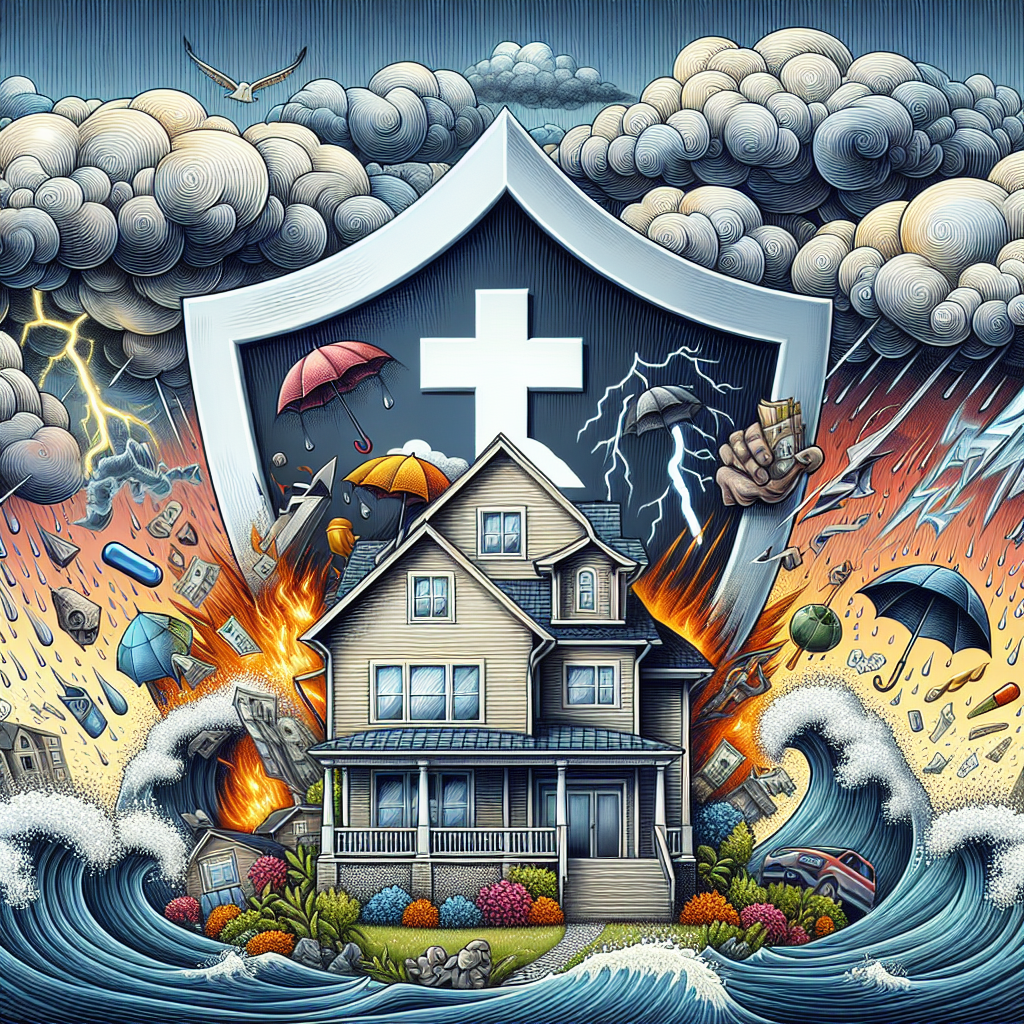Filed under Home Insurance on
How Much Coverage Should I Have for Home Insurance

Shopping for homeowners insurance isn’t just about finding a good price—it’s about getting the right amount of protection. If you’ve ever wondered, How Much Coverage Should I Have for Home Insurance, you’re asking the exact question that separates a policy that simply checks a box from one that truly safeguards your finances. Below, you’ll find a practical, research-informed guide to sizing your coverage so your home, belongings, and assets are protected when you need it most.
How Much Coverage Should I Have for Home Insurance? Start with the Big Picture
Home insurance is typically organized into six major buckets on an HO-3 (a common policy form):
- Dwelling (Coverage A): The structure you live in.
- Other Structures (Coverage B): Detached garage, fence, shed, or pool.
- Personal Property (Coverage C): Your belongings.
- Loss of Use/Additional Living Expenses (Coverage D): Extra costs if you can’t live at home during repairs.
- Personal Liability (Coverage E): Protects your assets if you’re legally responsible for injury or property damage.
- Medical Payments to Others (Coverage F): Pays small medical bills for guests injured on your property, regardless of fault.
To answer How Much Coverage Should I Have for Home Insurance, you’ll estimate each category based on the true cost to rebuild or replace—not what you paid for the house, not what your tax assessment says, and not what the market might fetch today.
Dwelling Coverage: Rebuilding Cost, Not Market Value
Dwelling coverage should be anchored to your home’s full reconstruction cost—the expense to rebuild the structure with similar materials and workmanship, at today’s labor and material prices, after a covered loss. Market value includes land and neighborhood desirability; insurance does not cover land. That’s why a $400,000 market-value home might need $500,000 of dwelling coverage if it’s large, custom-built, or costly to reconstruct in your area.
Industry trackers (including Verisk and CoreLogic) have reported significant reconstruction cost inflation in recent years, driven by labor shortages and materials volatility. Many regions saw double-digit increases from 2020 through 2023. That matters, because underinsuring—even by 10% to 20%—can leave you short thousands of dollars at claim time.
Practical Way to Estimate Dwelling Coverage
- Find local rebuild cost per square foot. Your agent or insurer’s replacement-cost calculator is best. As a ballpark, you can also ask local builders for a rough range for similar homes.
- Multiply by your finished square footage. Include attached structures like an attached garage and any high-end finishes (custom cabinetry, stone counters, hardwoods).
- Adjust for special features. Complex roofs, custom windows, masonry, built-ins, and unique architectural elements increase costs.
- Add a cushion. Consider an extended replacement cost endorsement (often 25% to 50% extra) to buffer against spikes in labor and materials after a catastrophe.
Example: If your home is 2,200 square feet and local rebuild costs are roughly $250 per square foot, your base dwelling estimate is $550,000. Add 25% extended replacement and you’re at approximately $687,500. That cushion can be the difference between finishing your rebuild or falling short if materials surge or code upgrades are necessary.
Ordinance or Law Coverage: Don’t Overlook Codes
Building codes change. If a fire damages part of your home, local ordinances may require updates to undamaged portions (electrical, plumbing, seismic retrofits, energy code compliance). Standard policies include a small amount of ordinance or law coverage, but older or heavily remodeled homes may need more—often 10% to 25% of Coverage A, and sometimes more for very old or historic homes.
Inflation Guard and Guaranteed Options
Look for inflation guard features that periodically increase your dwelling limit. In fast-moving markets, extended replacement cost (25%–50%) or guaranteed replacement cost (where available) can prevent gaps. If your insurer offers a guaranteed option, it’s usually worth considering for peace of mind, though availability varies by state and carrier.
Other Structures (Coverage B): Don’t Forget the Fence and Shed
Coverage B is commonly set at 10% of your dwelling limit by default. If your property has significant non-attached structures—detached garage, gazebo, retaining walls, a large fence, or a pool—verify that 10% is enough to reconstruct all of them. If not, increase it.
Personal Property (Coverage C): What It Takes to Replace Your Stuff
Most policies default to 50%–70% of dwelling coverage for personal property. If your home is insured for $600,000, your belongings might be covered for $300,000–$420,000 by default. That can be fine, but there are two crucial steps:
- Create a home inventory. Even a simple smartphone video walkthrough helps. For higher accuracy, list big-ticket items with photos, serial numbers, and receipts.
- Choose replacement cost, not actual cash value. Replacement cost pays to buy new items of similar kind and quality; actual cash value deducts depreciation.
Policies also include sublimits for certain categories—jewelry, watches, firearms, collectibles, silverware, fine art, furs, and sometimes electronics. If you own a $10,000 ring and your policy’s unscheduled jewelry sublimit is $1,500, you’ll need to “schedule” the ring with an appraisal or buy a personal articles policy. When you’re working through How Much Coverage Should I Have for Home Insurance, make sure these sublimits align with your valuables.
Loss of Use (Coverage D): Where Will You Live If You Can’t Live at Home?
Loss of Use pays for increased living expenses if a covered claim makes your home uninhabitable. Common defaults are 20%–30% of dwelling coverage or a time limit (like 12 or 24 months). In higher-cost rental markets, hotel and short-term rental costs can climb quickly. If it could take 12–18 months to rebuild after a major event—longer if your area experiences widespread losses—consider boosting this limit. FEMA has noted that even an inch of water can cause more than $25,000 in damage, and significant flood or fire claims can displace families for months. A robust Loss of Use limit helps keep your life on track.
When asking yourself, How Much Coverage Should I Have for Home Insurance, remember that the Loss of Use limit is about maintaining your lifestyle without draining savings during a long rebuild.
Liability (Coverage E) and Medical Payments (Coverage F): Protecting Your Assets
Personal liability covers legal defense and settlements if you’re found responsible for injuries or property damage. Limits often start at $100,000, but many experts—including the Insurance Information Institute—suggest at least $300,000, and $500,000 is common for homeowners with assets or future income to protect. If you have substantial assets, rental properties, or higher risk exposure (pool, trampoline, frequent entertaining), consider a personal umbrella policy that adds $1 million or more of liability protection above your home and auto coverage. Umbrella policies are often surprisingly affordable for the amount of protection they provide.
Medical Payments to Others typically ranges from $1,000 to $5,000. It’s not meant for large liability claims—that’s what Coverage E is for—but it can quickly handle minor injuries to guests without litigation.
From a practical standpoint, when you evaluate How Much Coverage Should I Have for Home Insurance, set liability with your net worth, future earnings, and risk factors in mind, not just the default numbers.
Deductibles: Your Share of the Risk
A higher deductible lowers your premium; a lower deductible reduces your out-of-pocket costs when you file a claim. Many homeowners choose $1,000 or $2,500 to balance affordability with protection. In some regions, separate deductibles apply for wind/hail or named storms (often 1%–5% of dwelling coverage). That means a 2% hurricane deductible on a $600,000 home is $12,000 out of pocket for storm damage—plan for this in your emergency fund.
Perils Often Not Covered by Standard Policies
- Flood: Not covered by standard home insurance. Consider a policy through the National Flood Insurance Program or private flood insurance—even outside high-risk zones, where premiums can be relatively modest. FEMA emphasizes that floods happen in every state, and the average loss can be financially devastating.
- Earthquake and Earth Movement: Usually excluded. Separate policies or endorsements are required in seismic zones.
- Sewer/Drain Backup: Typically excluded unless you add a rider. The cost is small compared to the mess and loss it can cause.
- Maintenance and Wear and Tear: Insurance covers sudden and accidental loss, not gradual issues like rot or neglect.
When mapping How Much Coverage Should I Have for Home Insurance, consider these add-ons based on your location and home systems.
Local Risk, Building Details, and Discounts That Matter
Rebuild cost and risk are hyperlocal. The same square footage can cost very different amounts to reconstruct depending on regional labor rates, distance to specialty trades, and building codes. House-specific details—roof age and material, foundation type, siding, custom finishes—also influence both coverage needs and price.
Mitigation upgrades can earn discounts and reduce loss severity:
- Roof: Impact-resistant shingles in hail-prone areas; sealed roof deck and enhanced nailing in hurricane zones; proper flashing and underlayment everywhere.
- Wind/Storm: Shutters or impact-rated windows and doors; reinforced garage doors; secondary water barrier.
- Wildfire: Defensible space; ember-resistant vents; Class A roofing; noncombustible landscaping near the structure.
- Water: Smart leak sensors and automatic shutoff valves.
Organizations like the Insurance Institute for Business & Home Safety (IBHS) have documented that fortified construction practices reduce damage in severe weather. Some insurers offer meaningful premium credits for certified mitigation improvements.
A Step-by-Step Worksheet to Right-Size Your Policy
- Dwelling: Use an insurer’s or agent’s replacement-cost estimator. Validate with local builders. Add extended or guaranteed replacement if available. Increase for unique finishes and code upgrades.
- Other Structures: List every detached item and estimate replacement cost. Increase above the default 10% if needed.
- Personal Property: Build an inventory. If your belongings exceed the default 50%–70% of Coverage A, raise the limit. Choose replacement cost coverage.
- Special Items: Check sublimits for jewelry, art, collectibles, musical instruments, and electronics. Schedule items individually if needed.
- Loss of Use: Estimate real-world costs for your area—rent, pet boarding, commuting changes, storage—and consider 12–24 months of coverage for major rebuilds.
- Liability: Start at $300,000 and consider $500,000 or higher. Add a personal umbrella if your assets and income warrant it.
- Deductibles: Align with your cash reserves and risk tolerance. Be mindful of separate wind/hail or hurricane deductibles.
- Additional Perils: Add flood, earthquake, or sewer backup based on your risk profile and local geography.
By following this worksheet, you’re methodically answering How Much Coverage Should I Have for Home Insurance with numbers tailored to your home and finances.
Common Mistakes That Lead to Costly Gaps
- Using market value instead of rebuild cost for dwelling coverage.
- Forgetting to increase coverage after a renovation or addition.
- Assuming default sublimits cover high-value items.
- Underestimating Loss of Use in high-rent areas.
- Choosing actual cash value for belongings to save a few dollars, then regretting it after a claim.
- Ignoring ordinance or law coverage for older homes.
- Overlooking separate peril policies (flood, earthquake, sewer backup).
Real-World Claim Scenarios to Pressure-Test Your Limits
- Kitchen Fire: Smoke and water damage forces a four-month displacement. Without sufficient Loss of Use, hotel and rental costs can erode savings.
- Hailstorm: A percentage wind/hail deductible means you pay thousands before coverage kicks in. Plan your deductible around your emergency fund.
- Burglary: Replacement cost coverage for personal property replaces stolen items at today’s prices; ACV may fall short after depreciation.
- Injury on Your Property: Adequate liability (and possibly an umbrella) protects your assets if you’re sued.
FAQs Homeowners Ask
Is market value the same as coverage?
No. Insurance is based on reconstruction cost, not what your home could sell for. Land isn’t insured, and market value can be lower or higher than rebuild cost depending on your area.
How often should I review my limits?
At least annually, and after any renovation, addition, or major purchase. Update your inventory and talk with your agent if construction costs or local rents are rising.
Do I need extended or guaranteed replacement?
If available, it’s wise—especially in areas prone to catastrophes, where labor and material costs can spike after widespread damage.
What about inflation?
Look for inflation guard. Given recent volatility, consider higher cushions (like 25%–50% extended replacement) to avoid shortfalls.
Is flood insurance necessary if I’m not in a high-risk zone?
Not required, but often recommended. Flooding occurs outside designated high-risk areas, and even small amounts of water can be expensive to repair. Premiums may be modest in lower-risk zones.
Annual Policy Checkup: A Quick Checklist
- Dwelling coverage equals current rebuild cost; extended replacement in place.
- Ordinance or law coverage matches your home’s age and local code environment.
- Personal property inventory updated; high-value items scheduled.
- Loss of Use limit aligned with local rental and living costs.
- Liability limit at least $300,000; consider $500,000 or umbrella if warranted.
- Deductibles match your cash reserves; understand any percentage deductibles.
- Added flood/earthquake/sewer backup if indicated by your risks.
- Mitigation upgrades logged with your insurer for potential discounts.
Bringing It Together: Sample Sizing Logic
Imagine a 2,400-square-foot home with midrange finishes in a suburban area. Local builders suggest $240 per square foot for reconstruction. That implies $576,000 for dwelling. Add 25% extended replacement for volatility, bringing it to $720,000. You have a detached garage and fence worth $70,000 to rebuild, so increase Other Structures above the default 10% to match the true value. Your home inventory totals roughly $350,000 in belongings—within the 50%–70% range of Coverage A, but you add replacement cost and schedule a few pieces of jewelry. Rents in your area run $3,500–$4,000 a month, so you opt for 24 months of Loss of Use. You set liability at $500,000 given your household’s assets, and add a $1 million umbrella for extra protection. Finally, you choose a $2,500 all-peril deductible and confirm a 2% wind/hail deductible fits your emergency fund.
This example demonstrates how a few realistic assumptions can lead to a tailored, resilient policy answer to How Much Coverage Should I Have for Home Insurance.
What to Ask Your Agent or Broker
- Can you walk me through your replacement-cost estimate and assumptions (square footage, materials, local labor)?
- What extended or guaranteed replacement options are available, and what’s the cost?
- How much ordinance or law coverage do you recommend for a home of my age and type?
- What are the sublimits on valuables, and how do I schedule items?
- What’s my Loss of Use limit in dollars and time? Is it enough for my local rent market?
- Do I have separate wind/hail or hurricane deductibles? How would they apply?
- Which mitigation discounts apply if I upgrade my roof, windows, or add a leak shutoff system?
- Should I consider flood, earthquake, or sewer backup coverage based on my location?
Use the answers to refine your numbers and finalize How Much Coverage Should I Have for Home Insurance for your specific situation.
Trends and Expert Insights to Keep on Your Radar
- Construction Cost Volatility: Supply chain shifts and labor constraints continue to influence rebuild costs. A healthy buffer via extended replacement is increasingly valuable.
- Climate and Catastrophe Exposure: More frequent severe weather in many regions means paying attention to peril-specific deductibles and mitigation measures.
- Smart Home Tech: Leak detection, monitored security, and shutoff valves can reduce losses and may earn discounts—ask your carrier.
- Coverage Customization: Carriers are expanding endorsements for valuables, equipment breakdown, and service line coverage to address modern home systems.
The Bottom Line
Your homeowners insurance should be built on present-day reconstruction realities, an accurate inventory of what you own, and a candid view of your financial risk tolerance. There’s no one-size-fits-all answer to How Much Coverage Should I Have for Home Insurance, but there is a right-size answer for your home and your budget. Focus on replacement cost for the dwelling, honest limits for belongings, time-relevant Loss of Use, and liability that protects your assets. Revisit the policy annually, especially after renovations or market changes, and lean on an experienced agent to stress-test your assumptions.
Do this, and you’ll move from “hope it’s enough” to confident coverage—prepared for bad days, without overpaying on the good ones.




